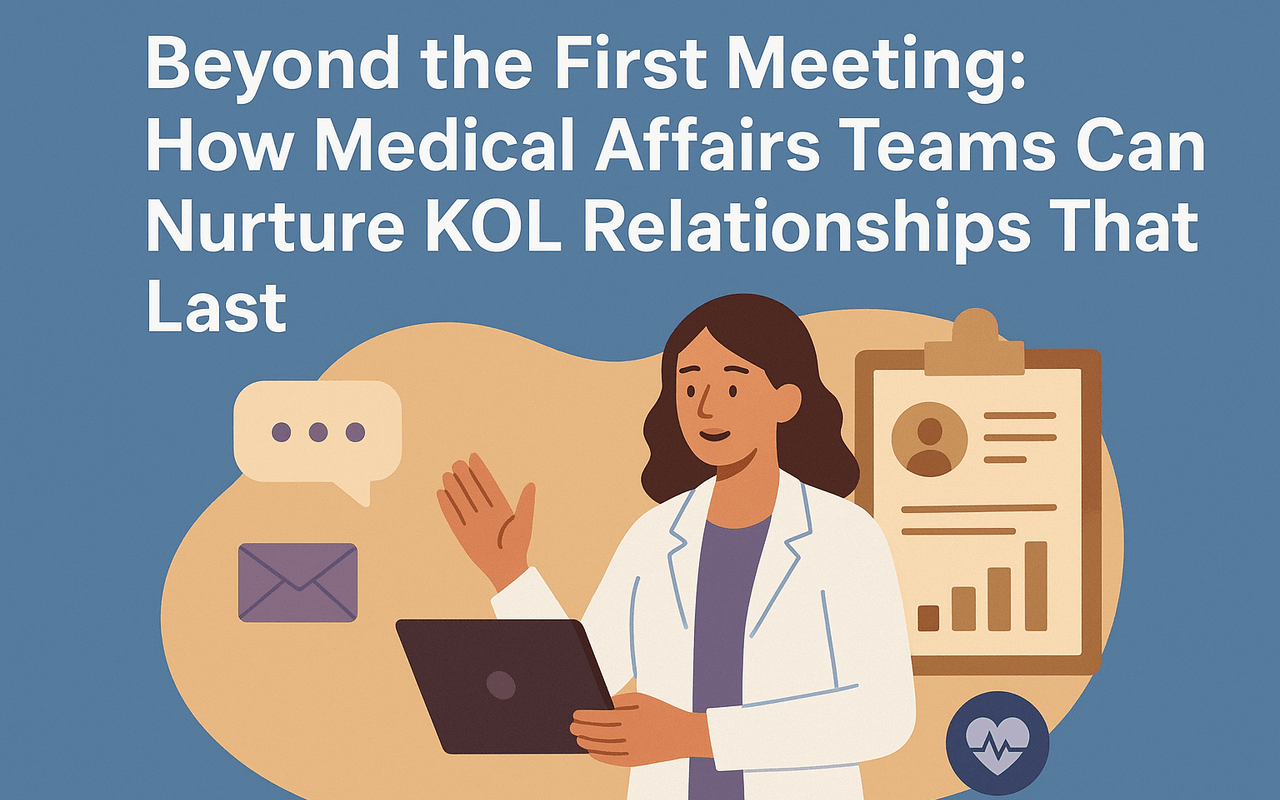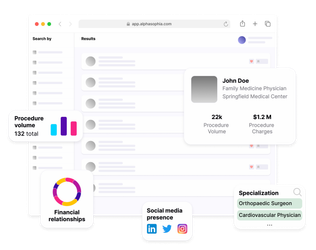Beyond the First Meeting: How Medical Affairs Teams Can Nurture KOL Relationships That Last

A first meeting with a Key Opinion Leader (KOL) is easy to celebrate and easy to waste, too. Industry playbooks note that the real value is captured in the follow-up, yet many teams struggle to re-engage after the initial touchpoint.
Real impact shows up months later when a KOL answers your email in a day, invites you to co-create a symposium session, or cites your evidence package in a guideline discussion.
That kind of long-term KOL engagement doesn’t happen by accident. It’s the result of disciplined KOL relationship management, consistent MSL–KOL interactions, and a data-driven Medical Affairs strategy that treats each interaction as part of a lifecycle.
The good news is that we know what KOLs say they want, we know where Medical Affairs teams get stuck, and we have better tools to act on both.
Surveys show KOLs prefer a hybrid engagement model, expect focused interactions, and take concrete actions after high-quality scientific exchange, changing therapy choices, or sharing insights with colleagues. But they’re also harder to reach and expect tighter relevance at every stage.
In this article, we lay out a practical blueprint, how to build KOL relationships, measure relationship health, and use Alpha Sophia to enable smarter, long-term KOL engagement at scale.
Why Long-Term KOL Engagement Matters
Long-term engagement compounds access, insight, and influence, and it does so across channels. A survey finds ~58–60% of planned interactions will remain face-to-face going forward, with the rest virtual. That hybrid mix is not a trend, it’s the new baseline clinicians ask for. Keep the in-person moments high-value and the virtual ones focused and brief.
The impact shows up in actions. After meaningful MSL exchanges, KOLs take 3-4 follow-ups on average, most often sharing insights with colleagues (≈56%), and ~50% report changing a treatment or line of therapy.
In other words, sustained scientific dialogue, delivered in the right format at the right time, translates into real changes in care.
Engagement also needs to begin earlier in the product lifecycle. A majority of KOLs want MSL contact by Phase 3, miss that window, and the probability of advancing understanding falls sharply because relevance and lead time shrink. The opportunity cost is the highest peri-launch.
Finally, relationships play out beyond one-to-one meetings. KOLs rate scientific congresses and conferences as essential group settings for learning and exchange, which means your plan should anticipate pre-, on-site, and post-congress touchpoints that connect back to ongoing conversations.
So, knowing why the long game matters is half the battle. The other half is avoiding the predictable mistakes that stall KOL relationships. Let’s map those pitfalls and how to fix them before we talk about tooling.
Common Pitfalls in KOL Relationship Management
The gap between a promising first meeting and a genuinely influential KOL partnership is rarely the result of one major error. It’s the accumulation of smaller, avoidable mistakes that erode trust, slow momentum, and make each new interaction harder to secure.
MAPS benchmarking shows most Medical-Affairs teams still measure success by the number of MSL/KOL interactions, even though the real determinant of impact is the quality, timing, and continuity of those exchanges. Below are the most common pitfalls and why they matter.
Treating Engagements As One-Off Transactions
A KOL relationship should read like a continuous story. When meetings are treated as isolated events, the conversation restarts from zero each time. This happens when different team members engage the same KOL without sharing context, or when there’s no system to link follow-up actions to the next interaction.
MAPS’ engagement framework notes that today’s KOLs influence well beyond direct clinical care through research, education, guideline development, and policy work.
If you don’t reference earlier exchanges, connect different channels of engagement, or build on prior discussions, the KOL experiences your outreach as fragmented. That lack of continuity erodes credibility and reduces the efficiency of every touchpoint.
Delivering Content Too Late In The Lifecycle
Timing is one of the strongest predictors of influence. Reports show that over 55% of KOLs expect substantive scientific engagement before or during Phase 3. This is when they can still influence trial interpretation, plan internal education, and prepare peers for adoption.
When teams wait until post-Phase 3, the opportunity to shape thinking diminishes, the market narrative often solidifies within weeks of data release. EMJ warns that this delay “significantly reduces” the ability to advance and disseminate scientific knowledge.
Over-Focusing On High-Profile Publishers And Ignoring Community Influence
It’s tempting to focus solely on global citation leaders, but real-world practice change often originates in community and regional settings. Data shows that 30% of global experts have no recorded MSL interactions, often because they operate outside the top-publication cohort.
These clinicians may have fewer publications but hold deep trust within local networks, making them critical in translating evidence into day-to-day practice. By overlooking community influencers, you risk gaps in market coverage and fail to seed adoption where it actually happens first.
Misaligned Cadence And Meeting Length
The same report highlights a clear mismatch, leaders plan ~34-minute in-person meetings, while KOLs prefer ~24 minutes, for virtual meetings, the ideal is ~21–26 minutes. Longer-than-preferred sessions increase drop-off risk, and shorter sessions without focus can feel superficial.
Consistently ignoring preferred cadence and length signals that you value your agenda over the KOL’s time, an easy way to erode goodwill and responsiveness.
Poor Targeting And KOL Inaccessibility
The same study also identifies KOL inaccessibility as the top Medical Affairs challenge. Outdated lists, inadequate segmentation, and generic outreach contribute to high no-show rates and lower engagement quality.
Without real-time intelligence on a KOL’s current focus areas, teams risk showing up with irrelevant content or missing optimal windows for dialogue. Every mistimed or off-target approach costs not just that meeting, but future access and credibility.
Weak Compliance Hygiene
Compliance lapses, such as missing role rationales, incomplete disclosure checks, or untracked financial engagements, can delay activities and damage relationships. In the U.S., Open Payments makes all manufacturer-to-HCP transfers of value public, so transparency is non-negotiable. Building compliance screening into your KOL engagement workflow is essential.
A single compliance oversight can nullify months of relationship-building and create reputational risk for both the company and the MSL.
By avoiding these pitfalls, you create the foundation for meaningful, trust-based engagement. The next step is to see how data platforms like Alpha Sophia can actively prevent these issues, helping you find the right experts, time your interactions precisely, and maintain a compliant, adaptive KOL strategy.
Using Alpha Sophia to Support Ongoing Engagement
Alpha Sophia gives Medical Affairs teams a single, continuously updated profile for every physician that blends scholarly reputation with real-world clinical reach, closing the information gaps that cause most engagement misfires.
Publication + Practice in One View
KOL AI indexes millions of PubMed records at the MeSH-topic level, then matches every author to an active physician profile that shows NPI, licences, hospital affiliations, Open Payments history, and live claims volume. This turns a static author list into a roster of reachable, credentialed experts.
Early Detection of Emerging KOLs
Because the platform ingests procedure and diagnosis claims, it flags clinicians whose clinical throughput is spiking, even if their publication count is still low. Teams can spot rising influencers months before they appear in citation rankings.
Network Intelligence, Not Only Names
Built-in co-authorship and peer-referral analytics highlight connectors with high local centrality, helping you prioritise voices that actually move prescribing behaviour, not just podium regulars.
Granular Targeting Filters
Search by seniority, subspecialty taxonomy, medical-society membership, geography, or research focus to tailor outreach lists to a specific study, launch, or advisory need, no more broad-brush emails.
Instant Compliance Screening
Real-time licence monitoring pulls updates from all 56 US state boards and exposes sanctions or expirations inside each profile, while Open Payments data is surfaced alongside past honoraria. Engagement plans pass medical-legal review faster because the evidence is already attached.
Trigger-Based Cadence
Dashboards alert MSLs when a KOL’s new abstract is accepted, when their procedure volume jumps, or when they join a pivotal trial, ideal moments to share updated data or invite collaboration, replacing generic quarterly check-ins with timely, value-led touches.
By unifying these data streams, Alpha Sophia makes KOL engagement a living map of influence so every follow-up is relevant, compliant, and delivered exactly when it matters.
Creating a KOL Nurturing Strategy
A first meeting opens the door, but a structured nurturing plan keeps it from swinging shut. That plan has to evolve as the molecule moves from pre-clinical to post-launch, and it has to treat every KOL as more than a name on a slide.
Below is a practical framework for turning sporadic contact into a disciplined, long-game programme.
Segment KOLs Dynamically
Start by grouping experts according to both scientific reach and real-world influence. A practical three-tier model works,
-
Tier 1 – guideline authors, trial PIs, and society officers with national visibility.
-
Tier 2 – regional specialists with high patient volumes or referral pull.
-
Tier 3 – “community KOLs” whose claims activity or peer‐to-peer influence is rising, even if publication counts are still low.
Case studies show that engaging Tier 3 voices early accelerates grassroots adoption because local physicians trust a respected peer more than a distant professor.
Review tiers quarterly, fresh claims or new abstract acceptances often signal a clinician ready to move up.
Align Objectives With Development Milestones
Match what you ask for and what you can credibly give, to where the molecule sits on the development curve.
As soon as a candidate enters Phase I, KOL AI can flag scientists publishing on mechanism or unmet need, so your early conversations zero in on protocol assumptions and patient-population nuances.
Through Phase II, you’re still validating endpoints, but by Phase III, the dialogue naturally shifts to selection criteria, dosing fine-tuning, emerging safety signals, and launch-readiness questions. Alpha Sophia surfaces the right experts at each inflection point, keeping the discussion in lock-step with the trial’s evolving evidence.
Post-launch, pivot to real-world evidence and subgroup optimisation. More than 55% of KOLs say they want substantial engagement no later than Phase III, warning that later contact feels purely promotional.
Calibrate Cadence And Channel Mix
A study finds that in-person meetings planned by internal teams average 34 minutes, while KOLs prefer ≈ 24 minutes, virtual sessions land best at 21–26 minutes. A workable rhythm is three to four purpose-built touches a year for Tier 1, tapering to one or two for Tier 3,delivered through a hybrid blend of brief virtual updates feeding into deeper face-to-face sessions.
Deliver Value-Driven Follow-Ups
Every interaction must leave something the KOL can use immediately. For example, a tailored evidence pack mapped to their patient mix, a one-page congress debrief, or a side-by-side of trial criteria versus real-world demographics.
Practical hand-offs like these turn contact into credibility and keep response times short, an early signal that the relationship is gaining momentum.
Embed Compliance From Day One
Role rationale, conflict checks, and transfer-of-value histories need to be surfaced before invitations go out. In the U.S., the Open Payments database publishes every manufacturer-to-HCP payment, refreshed each June and January, making discrepancies instantly visible. When compliance evidence rides inside the KOL profile, contracting cycles shrink and trust stays intact.
A clear nurturing plan sets direction, but you still need proof that the relationship is strengthening. That means tracking metrics that go beyond meeting counts to capture influence, responsiveness, and real clinical impact.
Start Your Omnichannel Strategy with Alpha Sophia

Metrics That Matter, Measuring Relationship Health
A dashboard crowded with call counts and slide-deck tallies won’t tell you whether a KOL relationship is healthy.
The organizations that scale influence track three signal groups, that is quantitative interaction data, qualitative insight flow, and behavioural outcomes and review them together each quarter.
Engagement Quality and Responsiveness
Start with baseline numbers like touches per quarter by tier, reply latency, and cancellation rate. Then pair those with qualitative “insight yield” like how many actionable insights surfaced and whether they triggered follow-ups.
MAPS’ Field Medical KPIs guidance stresses that counting insights without tracking follow-on actions “measures noise, not value.”
Influence Trajectory
Plot 12-month trend lines for publication velocity, procedure/claims volume, and network centrality. When any vector lifts sharply, the clinician is gaining authority, if two rise together, you have an emerging KOL worth higher-tier cadence. A recent white paper shows that spotting this “emergence period” early lets teams shape local adoption before guidelines change.
Outcome Signals
Internal benchmarking also finds that 65% of Medical Affairs groups now track outcome metrics, treatment-decision impact, peer advocacy, and insight-driven strategy shifts, rather than relying on activity tallies alone.
MAPS’ Metrics Benchmarking Report also recommends limiting the dashboard to ten KPIs, enough to capture direction without diluting focus and reviewing shifts against specific engagements every quarter.
When plotted side-by-side, these three signal groups show whether the relationship is compounding (faster replies, richer insights, rising influence) or stagnating (longer gaps, recycled questions, flat network reach).
Engagement Frequency, Responsiveness, Influence Growth
A spreadsheet full of call counts can look impressive and still hide a stagnant relationship. What Medical Affairs really needs is a three-signal dashboard that shows whether a KOL partnership is compounding or drifting.
Engagement Frequency
KOLs rate three to four purposeful touches per year as “about right” for priority relationships, above that, perceived relevance drops sharply, while below it, familiarity fades.
Internal calendars often default to quarterly check-ins, but Alpha Sophia users tighten frequency by setting triggers, new abstract acceptance, sudden uptick in procedure claims so outreach happens only when the KOL has fresh context to discuss.
Responsiveness
Monitoring first-reply time and meeting-acceptance lag tells you whether the relationship is gaining or losing urgency. A shortening response cycle after each interaction signals rising trust, a lengthening one is an early warning that content is missing the mark.
Influence Growth
A KOL’s citation count may be flat, yet their clinical influence can be climbing. Alpha Sophia tracks annualised change in publication velocity, patient throughput, and local network centrality, when two of those three vectors trend up together, you have an emerging influencer worth higher-tier attention.
Tie these three signals together and you have a living barometer of relationship health. If all three are moving in the right direction, the partnership is compounding, if any flat-line, you know exactly where to intervene.
FAQs
Why is KOL relationship nurturing important beyond initial contact?
A single meeting can spark interest, but sustained engagement turns a KOL into an advocate. More than 55 % of KOLs expect meaningful dialogue before or during Phase 3, and those who receive it are far likelier to share insights with peers and adjust practice patterns.
How can Alpha Sophia track changes in a KOL’s focus or activity?
The platform blends daily-refreshed PubMed data with weekly claims and referral feeds, then runs network analytics. When publication velocity, procedure volume, or local centrality spikes, Alpha Sophia flags the trend so MSLs can adjust cadence or content in real time.
What kind of data helps personalize ongoing KOL engagement?
High-impact programmes layer three lenses, scholarly output, clinical reality, and peer reach. Alpha Sophia surfaces all three in one dashboard, while Veeva benchmarking shows that adding clinical and network data uncovers ~30 % of influencers missed by publication-only lists.
How often should MSLs engage with KOLs for sustained relationships?
Field studies point to three to four purposeful touches per year for priority KOLs; beyond that, relevance drops, and below it, familiarity fades. Hybrid formats,brief virtual updates feeding richer in-person sessions,fit the 24-minute meeting preference documented by ZS.
Can Alpha Sophia identify timely triggers for reconnecting with a KOL?
Yes. A quick targeted search in the dashboard surfaces new abstract acceptances, trial-site listings, or sudden jumps in procedure volume, letting MSLs time their outreach when it’s most relevant instead of relying on routine calendar check-ins.
What are signs that a KOL relationship is growing stronger or stagnating?
Shorter reply times, inbound data requests, and rising network centrality signal strength; longer gaps and flat influence vectors point to stagnation. Definitive HC advises pairing responsiveness metrics with influence trend-lines to catch a plateau early.
How do you segment KOLs for different engagement strategies?
Use dynamic tiers, Tier 1 (national leaders), Tier 2 (regional high-volume clinicians), Tier 3 (emerging community influencers). Refresh segmentation quarterly so rising procedure volume or new publications promote a clinician promptly,something Alpha Sophia automates.
What are some examples of value-driven follow-ups for KOLs?
Tailored evidence packs that map trial criteria to the KOL’s patient mix, one-page congress wrap-ups relevant to their clinic, or concise safety updates they can share internally. EMJ notes that pragmatic take-aways like these outperform broad slide decks in perceived usefulness.
How can Medical Affairs align with commercial teams in KOL nurturing?
Set shared objectives,such as closing evidence gaps,then exchange aggregated insights (never promotional messaging). MAPS’ ecosystem framework recommends maintaining a unified KOL profile capturing scientific, market-access, and educational touchpoints to avoid duplicated outreach.
Can Alpha Sophia support global KOL relationship management across markets?
Yes. KOL AI indexes millions of global publications and maps authors to licensed physician records in 40+ countries. Clinical data coverage spans the U.S., several EU markets, and selected APAC regions, with network analytics wherever claims or referral feeds exist.
Conclusion
Long-term KOL engagement is delivering the right science, at the right depth, to the right clinician, exactly when it matters.
Avoiding transactional touchpoints, engaging no later than Phase 3, and broadening the lens beyond headline publishers create the baseline. Alpha Sophia’s unified view of publications, clinical activity, network reach, and compliance data turns that baseline into an adaptive, trigger-based programme.
Layer on a clear nurturing strategy and measure progress with integrated KPIs that tie every interaction back to influence and behaviour. When those pieces click, the first meeting becomes the start of a partnership that advances science and accelerates appropriate patient care.
Every US physician at your fingertips. Always.

